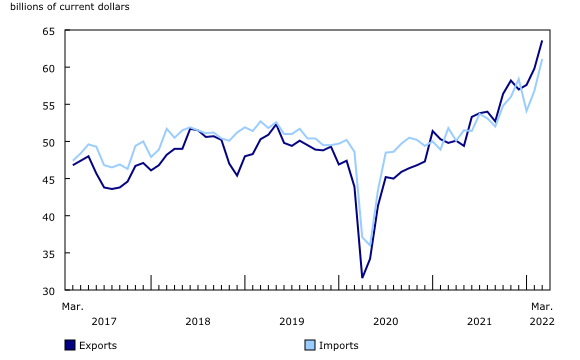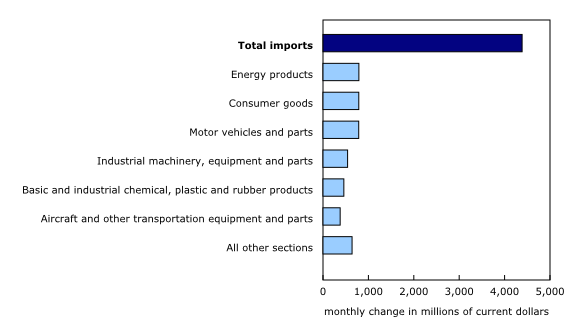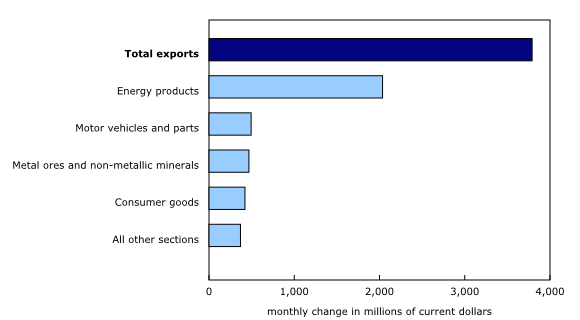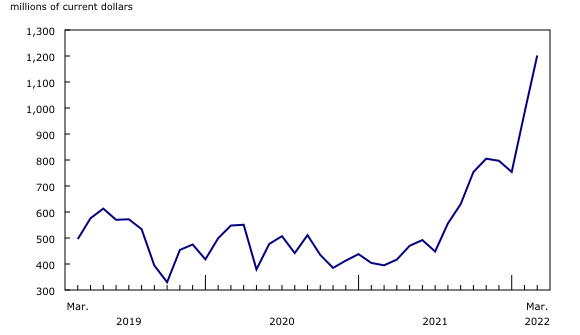Canadian international merchandise trade, March 2022
Archived Content
Information identified as archived is provided for reference, research or recordkeeping purposes. It is not subject to the Government of Canada Web Standards and has not been altered or updated since it was archived. Please "contact us" to request a format other than those available.
Released: 2022-05-04
Canada's merchandise trade increased substantially in March, with both imports and exports reaching record highs. Following a 4.8% increase in February, imports jumped a further 7.7% in March. Meanwhile, exports rose 6.3%, with energy products contributing more than half of the increase. As a result, Canada's merchandise trade surplus with the world narrowed from $3.1 billion in February to $2.5 billion in March.
Consult the "International trade monthly interactive dashboard" to explore the most recent results of Canada's international trade in an interactive format.
Widespread increases in imports
Total imports rose 7.7% in March to a record high of $61.1 billion. Gains were observed in 9 of 11 product categories, with 8 posting increases of more than $100 million. In real (or volume) terms, total imports were up 7.0%.
Imports of energy products posted significant gains in March, rising 26.3%. Higher imports of crude oil and bitumen (+39.9%) were largely behind the increase, with both prices and volumes rising markedly. The increase in imports of crude oil coincided with the Russian aggression in Ukraine and the resulting sanctions against Russia, creating uncertainty around future availability of energy products. The United States is by far the top source for Canada's crude oil imports, but substantial increases in imports from Saudi Arabia and Nigeria were also observed in March.
Consumer goods (+6.5%) were also a contributor to the rise in total imports in March. Increases were observed in a number of sub-categories, with clothing, footwear and accessories (+15.9%) posting the largest gain. Imports for this product category have been unstable since the onset of the COVID-19 pandemic, with typical trends being disrupted by several factors, resulting in greater monthly variations on a seasonally adjusted basis.
Following a large decrease in January, imports of motor vehicles and parts were up for a second consecutive month, rising 9.9% in March. Imports of passenger cars and light trucks (+19.2%) were behind the increase in March, reflecting the recent ramp up in North American production of motor vehicles. Supply chain bottlenecks, in particular the global semiconductor chip shortage, have influenced imports within the motor vehicles and parts category since early 2021.
In March, substantial increases in imports were also observed in several other categories, including industrial machinery, equipment and parts (+8.8%), basic and industrial chemical, plastic and rubber products (+8.8%), and aircraft and other transportation equipment and parts (+24.6%).
Export prices continue to rise in March
Total exports increased by 6.3% to $63.6 billion in March, surpassing the previous record set in February by nearly $4 billion. Excluding energy products, exports were up 4.0% in March. Once again, higher prices were a key factor in the month, with total exports in real (or volume) terms up 1.1%. The price index for Canadian total exports has increased by more than 30% since January 2021.
Exports of energy products rose 12.8% to a record $17.9 billion in March. Energy products accounted for 28.2% of total exports, an increase of almost 10 percentage points from the share of 18.3% observed in March 2021. Similar to February 2022, exports of crude oil (+14.8%) contributed most to the growth in March. Market prices for crude oil experienced extreme volatility throughout the month, but were up substantially on average in March, as the conflict in Ukraine and sanctions against Russia raised the level of uncertainty surrounding global supply. Higher prices were the main factor behind the increase in Canadian crude oil exports in March, while volumes were down. Exports of crude oil are estimated for the most recent reference month, and these estimates are subject to larger revisions during times of high price volatility.
Exports of motor vehicles and parts increased by 7.9% in March. This movement was led by an increase in exports of passenger cars and light trucks (+8.3%). This reflected higher manufacturing activity throughout North America, as automakers experienced a reprieve from supply chain issues that have been limiting output for a number of months. Overall, Canadian production was less affected in March by disruptions related to semiconductor shortages, and exports of passenger cars and light trucks, not seasonally adjusted, reached their highest level since November 2020.
Exports of metal ores and non-metallic minerals increased in March by 19.4% to a record $2.9 billion. Following a 30.1% gain in February, exports of potash (+22.5%) contributed the most to the increase in March. Demand for Canadian fertilizers has increased since the Russian invasion of Ukraine and the resulting sanctions that have been imposed on trade with Russia, pushing Canadian exports of potash to record levels. Following three consecutive months of lows, exports of iron ores (+21.0%) increased in March.
Trade surplus with the United States reaches an all-time high
Exports to the United States increased by 7.7% in March, largely because of higher exports of crude oil. Meanwhile, imports from the United States increased by 5.4%, mainly because of higher imports of energy products and motor vehicles and parts. As a result, Canada's trade surplus with the United States widened from $10.9 billion in February to a record $12.6 billion in March.
When the average exchange rates of February and March are compared, the Canadian dollar gained 0.4 US cents relative to the American dollar.
Imports from China rise sharply for a second consecutive month
Imports from countries other than the United States were up 11.5% in March, reaching a record $24.5 billion. Imports from China (+29.4%) posted the largest gain by far. Computers and cellphones, industrial machinery, and consumer goods topped widespread increases in imports from this country.
Exports to countries other than the United States were up 1.9% in March to $14.4 billion, which also constitutes a record. There were higher exports to the United Kingdom (gold), Spain (pharmaceutical products), South Korea (coal) and Germany (various products).
After the $7.9 billion deficit observed in February, the merchandise trade deficit with countries other than the United States reached a record $10.1 billion in March.
Seventh consecutive quarterly increase for both exports and imports
Total exports rose 5.5% in the first quarter of 2022, a seventh consecutive quarterly increase. This movement was led by higher exports of energy products (+16.4%). These have been climbing consistently since the second quarter of 2020, mainly because of higher prices. Excluding energy products, total exports were up 2.0% in the first quarter of 2022. Exports of forestry products and building and packaging materials (+12.1%) also contributed to the quarterly increase, mainly on higher prices.
Total imports rose 1.7% in the first quarter of 2022, also a seventh consecutive quarterly increase. Despite the growth in quarterly imports, the largest movement of the quarter was a decrease in motor vehicles and parts (-5.8%). This decline was largely attributable to supply chain issues that have been present since early 2021. This decrease was more than offset by widespread increases throughout other product sections.
Canada's quarterly merchandise trade surplus widened from $2.5 billion in the fourth quarter of 2021 to $9.0 billion in the first quarter of 2022, a third consecutive surplus, and the largest since 2008.
Exports in constant dollars (using chained 2012 dollars) fell 2.5% in the first quarter of 2022, while quarterly imports in constant dollars were down 1.0%.
Revisions to February merchandise export and import data
Imports in February, originally reported at $56.1 billion in the previous release, were revised to $56.8 billion in the current reference month's release. Exports in February, originally reported at $58.7 billion in the previous release, were revised to $59.8 billion in the current reference month's release, mainly because estimates for crude oil were replaced with actual data.
Monthly trade in services
In March, monthly service exports rose 2.9% to $11.9 billion. Service imports increased 6.5% to $12.9 billion.
When international trade in goods and international trade in services were combined, exports increased 5.8% to $75.5 billion in March, while imports were up 7.5% to $74.0 billion. As a result, Canada's trade surplus with the world went from $2.5 billion in February to $1.4 billion in March.
Note to readers
Merchandise trade is one component of Canada's international balance of payments (BOP), which also includes trade in services, investment income, current transfers, and capital and financial flows.
International trade data by commodity are available on both a BOP and a customs basis. International trade data by country are available on a customs basis for all countries and on a BOP basis for Canada's 27 principal trading partners (PTPs). The list of PTPs is based on their annual share of total merchandise trade—imports and exports—with Canada in 2012. BOP data are derived from customs data by adjusting for factors such as valuation, coverage, timing and residency. These adjustments are made to conform to the concepts and definitions of the Canadian System of National Accounts.
For a conceptual analysis of BOP-based data versus customs-based data, see "Balance of Payments trade in goods at Statistics Canada: Expanding geographic detail to 27 principal trading partners."
For more information on these and other macroeconomic concepts, see the Methodological Guide: Canadian System of Macroeconomic Accounts (13-607-X) and the User Guide: Canadian System of Macroeconomic Accounts (13-606-G).
The data in this release are on a BOP basis and are seasonally adjusted. Unless otherwise stated, values are expressed in nominal terms, or current dollars. References to prices are based on aggregate Paasche (current-weighted) price indexes (2012=100). Movements within aggregate Paasche prices can be influenced by changes in the share of values traded for specific goods, with sudden shifts in trading patterns—as observed currently with the COVID-19 pandemic—sometimes resulting in large movements in Paasche price indexes. Volumes, or constant dollars, are calculated using the Laspeyres formula (2012=100), unless otherwise stated.
For information on seasonal adjustment, see Seasonally adjusted data – Frequently asked questions.
Revisions
In general, merchandise trade data are revised on an ongoing basis for each month of the current year. Current-year revisions are reflected in both the customs-based and the BOP-based data.
The previous year's customs-based data are revised with the release of data for the January and February reference months, and thereafter on a quarterly basis. The previous two years of customs-based data are revised annually, and revisions are released in February with the December reference month.
The previous year's BOP-based data are revised with the release of data for the January, February, March and April reference months. To remain consistent with the Canadian System of Macroeconomic Accounts, revisions to BOP-based data for previous years are released annually in December with the October reference month.
Factors influencing revisions include the late receipt of import and export documentation, incorrect information on customs forms, the replacement of estimates produced for the energy section with actual figures, changes in merchandise classification based on more current information, and changes to seasonal adjustment factors. The seasonal adjustment parameters are reviewed and updated annually, and applied with the October reference month release.
For information on data revisions for exports of energy products, see Methodology for Exports of Energy Products within the International Merchandise Trade Program.
Revised data are available in the appropriate tables.
Real-time data table
The real-time data table 12-10-0120-01 will be updated on May 16.
Next release
Data on Canadian international merchandise trade for April will be released on July 7.
Products
The product "International trade monthly interactive dashboard" (71-607-X) is now available. This new interactive dashboard is a comprehensive analytical tool that presents monthly changes in Canada's international merchandise trade data on a balance-of-payments basis, fully supporting the information presented every month in the Daily release.
The product "The International Trade Explorer" (71-607-X) is now available online.
The Canadian International Merchandise Trade online database is no longer available. It has been replaced by the Canadian International Merchandise Trade Web Application (71-607-X), a modern tool that provides trade data users with a number of enhancements.
The updated "Canada and the World Statistics Hub" (13-609-X) is now available online. This product illustrates the nature and extent of Canada's economic and financial relationship with the world using interactive charts and tables. It provides easy access to information on trade, investment, employment and travel between Canada and a number of countries, including the United States, the United Kingdom, Mexico, China, Japan, Belgium, Italy, the Netherlands and Spain.
Contact information
For more information, or to enquire about the concepts, methods or data quality of this release, contact us (toll-free 1-800-263-1136; 514-283-8300; infostats@statcan.gc.ca) or Media Relations (statcan.mediahotline-ligneinfomedias.statcan@statcan.gc.ca).
- Date modified:









